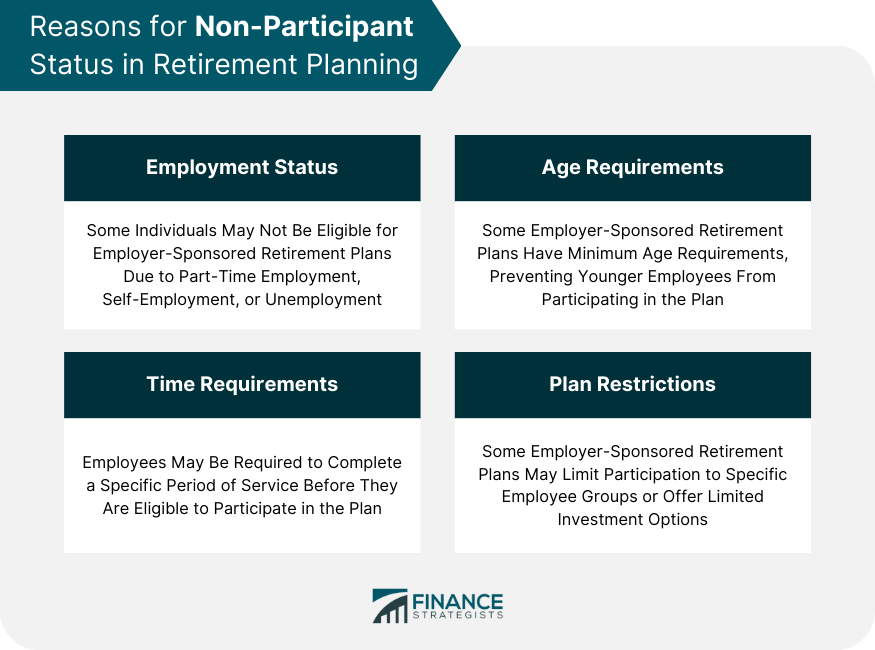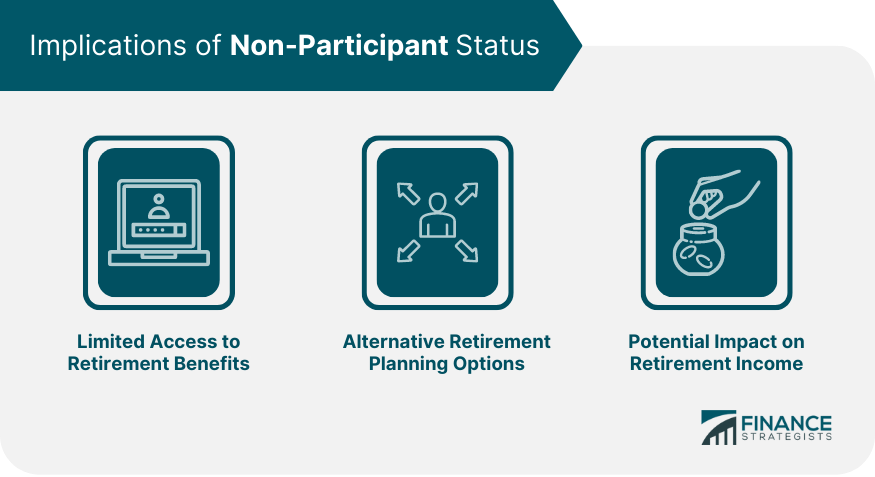A non-participant in retirement planning is an individual who is not currently enrolled in or contributing to an employer-sponsored retirement plan. Understanding the reasons for and implications of non-participant status is crucial for effective retirement planning. Non-participant status may result from various factors, including employment status, age, and plan restrictions. Recognizing the importance of non-participant status in retirement planning is essential for individuals to take control of their financial future. By understanding the reasons behind non-participation, individuals can explore alternative retirement planning strategies to secure a comfortable retirement. Understanding non-participant status helps individuals make informed decisions about their retirement savings and investments. Employment status plays a significant role in retirement planning. Full-time employees often have access to employer-sponsored retirement plans, such as 401(k)s in the United States. However, part-time employees may not be eligible for these plans, depending on the employer's policies. Self-employed individuals and small business owners may need to set up their own retirement plans, such as a SEP IRA or a Solo 401(k). Unemployed individuals, meanwhile, may have to rely on personal savings or government programs for their retirement needs. Understanding these dynamics can help individuals identify the best retirement savings options for their specific employment situation. Many employer-sponsored retirement plans have minimum age requirements, often set at 21 years. This means that younger employees may not be able to start contributing to these plans as soon as they start working. However, they can still start saving for retirement in other ways, such as by opening an individual retirement account (IRA) or by investing in a taxable brokerage account. Understanding age requirements can help individuals plan their retirement savings strategy and take full advantage of the power of compound interest. Some employer-sponsored retirement plans require employees to complete a certain period of service before they can participate in the plan. This is known as a vesting period. For example, an employer might require an employee to work for the company for a year before they can start contributing to the 401(k) plan. Understanding these time requirements can help individuals plan their retirement savings strategy and ensure they are taking full advantage of any employer-sponsored plans for which they are eligible. Employer-sponsored retirement plans may have various restrictions that can affect an individual's ability to participate. For example, some plans may only be available to certain groups of employees, such as executives or managers. Other plans may offer a limited selection of investment options, which can be a deterrent for employees who want more control over their investments. Understanding these restrictions can help individuals make informed decisions about their retirement savings strategy and explore alternative options if necessary. For example, an individual might choose to contribute to an IRA in addition to or instead of an employer-sponsored plan to have more control over their investment choices. Non-participant status can result in limited access to retirement benefits, potentially impacting an individual's ability to accumulate sufficient savings for a comfortable retirement. Understanding the implications of limited retirement benefits can help individuals make informed decisions about their retirement planning strategy. For non-participants, alternative retirement planning options may be necessary to achieve their retirement savings goals. These options may include individual retirement accounts, annuities, and pension maximization strategies. Exploring alternative retirement planning options can help non-participants build a diverse retirement savings portfolio. Non-participant status can have a significant impact on retirement income, potentially resulting in lower savings and reduced financial security during retirement. Understanding the potential impact of non-participant status on retirement income can help individuals take proactive steps to secure their financial future. One strategy for non-participants is to invest in individual retirement accounts (IRAs), such as traditional IRAs or Roth IRAs. These accounts offer tax advantages and flexibility for individuals who are not eligible for employer-sponsored retirement plans. IRAs can provide non-participants with a valuable savings tool to help secure their retirement. Deferred annuities are another retirement planning option for non-participants. These insurance products allow individuals to invest in a contract with an insurance company, providing a guaranteed stream of income during retirement. Deferred annuities can offer non-participants a secure and predictable source of retirement income. Non-participants may also benefit from their spouse's employer-sponsored savings plans, such as 401(k) or 403(b) plans. By contributing to a spouse's plan, non-participants can still take advantage of tax-deferred growth and potential employer-matching contributions. Leveraging a spouse's retirement plan can help non-participants build a more robust retirement savings strategy. Pension maximization strategies can also benefit non-participants, especially those with a spouse who has a pension. These strategies involve optimizing pension payouts and using life insurance to provide additional income for the surviving spouse. Pension maximization can help non-participants ensure financial security for themselves and their spouses during retirement. Non-participant status refers to individuals who are not currently enrolled in or contributing to an employer-sponsored retirement plan. This status can result from various factors, including employment status, age requirements, time requirements, and plan restrictions. Employment status significantly influences retirement planning. Full-time employees often have access to employer-sponsored retirement plans, while part-time employees, self-employed individuals, and unemployed individuals may face limitations. Age and time requirements can also prevent individuals from participating in these plans. Additionally, plan restrictions may limit participation to specific employee groups or offer limited investment options. Non-participant status can have significant implications, including limited access to retirement benefits and a potential impact on retirement income. As a result, non-participants may need to explore alternative retirement planning options to achieve their retirement savings goals. These options can include individual retirement accounts (IRAs), deferred annuities, employer-sponsored savings plans for spouses, and pension maximization strategies. Understanding the reasons behind non-participant status and its implications can help individuals make informed decisions about their retirement savings and investments. By exploring alternative retirement planning strategies, non-participants can take control of their financial future and work towards securing a comfortable retirement.What Is a Non-Participant?
Reasons for Non-Participant Status
Employment Status
Age Requirements
Time Requirements
Plan Restrictions

Implications of Non-Participant Status
Limited Access to Retirement Benefits
Alternative Retirement Planning Options
Potential Impact on Retirement Income

Strategies for Non-Participants
Individual Retirement Accounts (IRAs)
Deferred Annuities
Employer-Sponsored Savings Plans for Spouses
Pension Maximization Strategies
Final Thoughts
Non-Participant FAQs
Non-Participant refers to an individual who is not eligible to participate in an employer-sponsored retirement plan.
Reasons for Non-Participant status may include employment status, age requirements, time requirements, and plan restrictions.
Non-Participants may have limited access to retirement benefits and may need to seek alternative retirement planning options that could impact their retirement income.
Non-Participants can use individual retirement accounts (IRAs), deferred annuities, employer-sponsored savings plans for spouses, and pension maximization strategies to plan for retirement.
You can check with your employer's human resources department or plan administrator to determine if you are eligible to participate in the company's retirement plan.
True Tamplin is a published author, public speaker, CEO of UpDigital, and founder of Finance Strategists.
True is a Certified Educator in Personal Finance (CEPF®), author of The Handy Financial Ratios Guide, a member of the Society for Advancing Business Editing and Writing, contributes to his financial education site, Finance Strategists, and has spoken to various financial communities such as the CFA Institute, as well as university students like his Alma mater, Biola University, where he received a bachelor of science in business and data analytics.
To learn more about True, visit his personal website or view his author profiles on Amazon, Nasdaq and Forbes.















